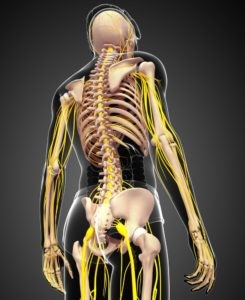The Right Pillow Can Make All The Difference
Author: Julie Donnelly, LMT – The Pain Relief Expert
Editor: Dr. Steve Chaney
 Sleeping on your stomach has several negative outcomes, which fortunately can be overcome. As your spine is twisting to enable you to turn your head, you are impinging on nerves, disks, and veins.
Sleeping on your stomach has several negative outcomes, which fortunately can be overcome. As your spine is twisting to enable you to turn your head, you are impinging on nerves, disks, and veins.
The pressure causes a long list of aches and pains, often far from the source of the problem.
Why Sleeping on Your Stomach is Bad for Your Neck
As you look at the healthy spine graphic, consider what happens to the neck bones when the head is turned. The cervical vertebrae are twisted, which puts a strain on your spinal cord, at the base of your brain. Plus, your carotid artery is potentially being squeezed, and your nerves are being pressed on by the bones.
If your head is turned to the left, your neck and shoulder muscles on the left are being held tight. Meanwhile, the muscles on your right are being overstretched, and then held that way for hours. This puts great pressure on all the structures of your neck.
While prevention is optimal, you can learn how to treat each of the muscles that are being strained as you sleep on your stomach. Releasing tight muscles every day will help avoid some of the damage that is done by having your head twisted.
Why Sleeping on Your Stomach is Bad for Your Lower Back
 Your spinal cord runs from your brain all the way to your feet. As your nerves break off to every area of your body, an impingement causes pain, numbness and tingling
Your spinal cord runs from your brain all the way to your feet. As your nerves break off to every area of your body, an impingement causes pain, numbness and tingling
When you are sleeping on your stomach, your lower back (lumbar) vertebrae will drop forward. This causes your lumbar vertebrae to press into your spinal cord.
The muscles of your lower back; psoas, quadratus lumborum and erector spinae, are affected while sleeping on your stomach.
You can learn how to do simple self-treatments to eliminate lower back pain in my book “The 15 Minute Back Pain Solution.” This is a step-by-step program that treats each muscle involved in lower back pain, sciatica, and more.
How to Reduce Pain From Sleeping on Your Stomach
 It’s best to stop sleeping on your stomach, but habits are a challenge to break. While you’re working to change this habit, here are a few tips to help relieve muscle tension and pain now.
It’s best to stop sleeping on your stomach, but habits are a challenge to break. While you’re working to change this habit, here are a few tips to help relieve muscle tension and pain now.
In my therapy practice I have used a cushion that holds the body in a perfect face down position. A cushion holds the clients head, which is face down, and their abdomen is supported to prevent the lumbar curve. Some of my clients who sleep on their stomach feel it’s so comfortable they have bought it for their home. Here’s how you can create the same effect without the expense of buying the cushions.
Click on the link above to see how the Body Support cushion works, and then follow along with me.
Begin to change the way you sleep by buying a very dense king-size pillow. Lie on top of the pillow with your trunk and have your knees on the bed. Put pillows under your ankles, which will help support the curve of your lower back.
It’s challenging to re-create the face cradle, and the odds of sleeping with your face down are slim. However, if the pillow under your trunk comes all the way up to your chin, you can have your head bent forward and only slightly turned. The idea is to have as little of a twist as possible in your neck.
You also want to avoid having your lower back collapse into the mattress. The dense pillow under your trunk will support your lumbar vertebrae and prevent low back pain.
Whenever possible, try to start to sleep on your side, supporting your head to keep your spine straight. It’s a challenge, but it’s worth the effort.
Wishing you well,
Julie Donnelly
About The Author
 Julie Donnelly is a Deep Muscle Massage Therapist with 20 years of experience specializing in the treatment of chronic joint pain and sports injuries. She has worked extensively with elite athletes and patients who have been unsuccessful at finding relief through the more conventional therapies.
Julie Donnelly is a Deep Muscle Massage Therapist with 20 years of experience specializing in the treatment of chronic joint pain and sports injuries. She has worked extensively with elite athletes and patients who have been unsuccessful at finding relief through the more conventional therapies.
She has been widely published, both on – and off – line, in magazines, newsletters, and newspapers around the country. She is also often chosen to speak at national conventions, medical schools, and health facilities nationwide.
These statements have not been evaluated by the Food and Drug Administration. This information is not intended to diagnose, treat, cure or prevent any disease.
